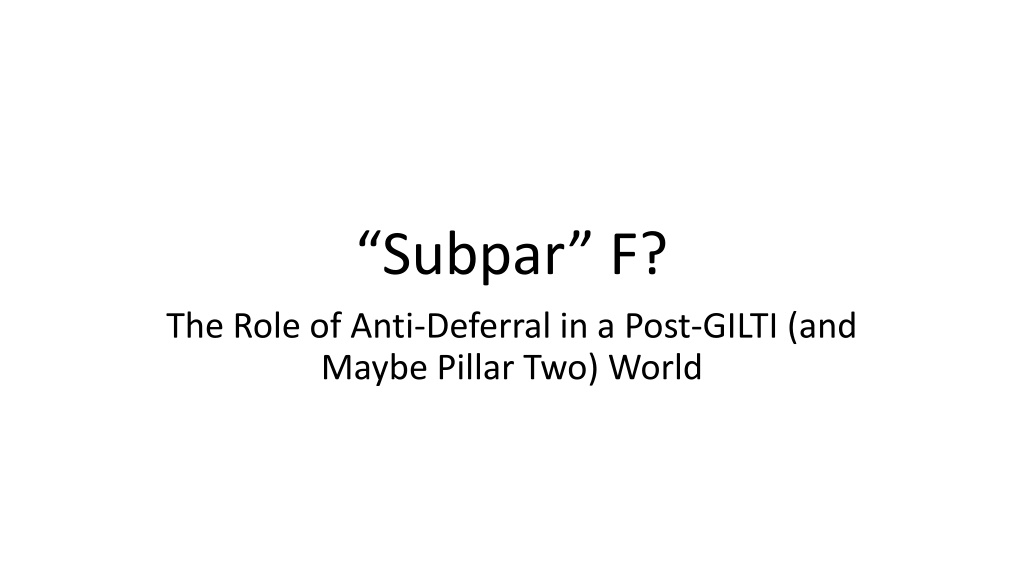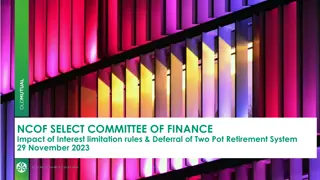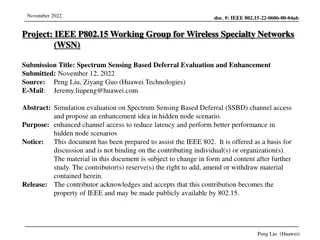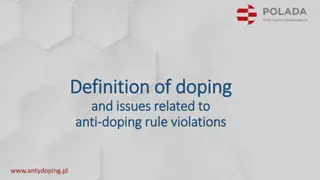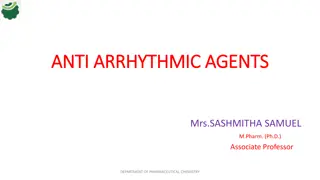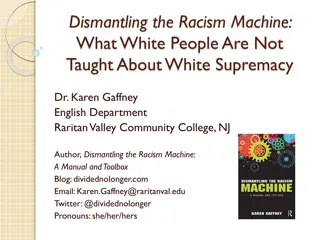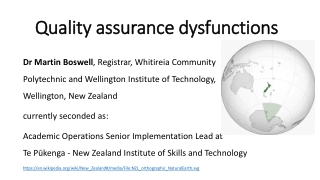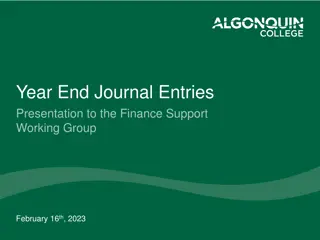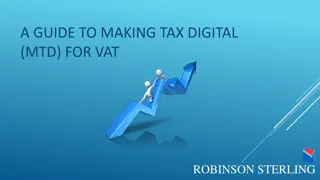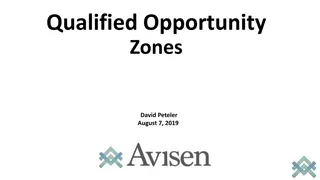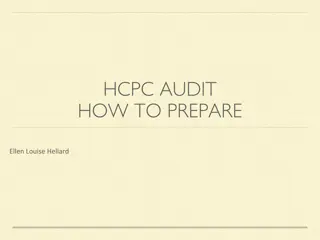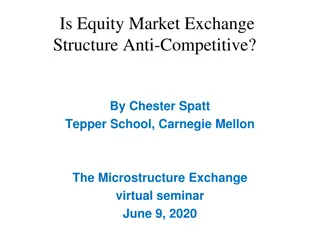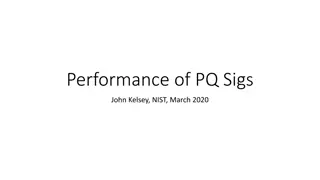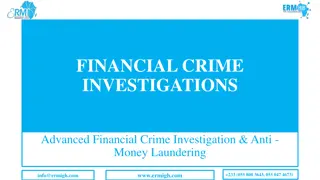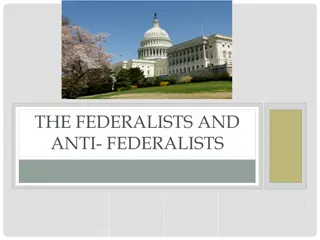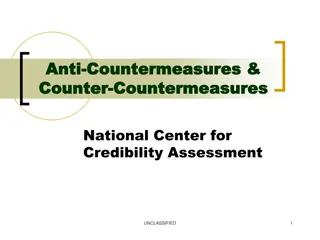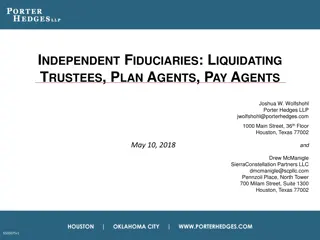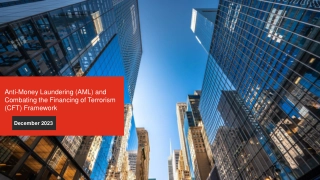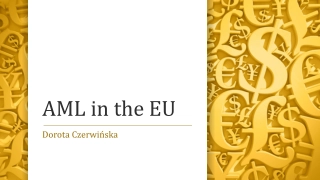The Role of Anti-Deferral in a Post-GILTI World
Surveying the evolution of international taxation, exploring the impact of source and residence taxation on subpart F, proposing a modified GILTI aligned with Pillar Two, advocating for a streamlined residence-based tax system, and recommending restrictions on subpart F to focus on passive income and specific entities.
Download Presentation

Please find below an Image/Link to download the presentation.
The content on the website is provided AS IS for your information and personal use only. It may not be sold, licensed, or shared on other websites without obtaining consent from the author. Download presentation by click this link. If you encounter any issues during the download, it is possible that the publisher has removed the file from their server.
E N D
Presentation Transcript
Subpar F? The Role of Anti-Deferral in a Post-GILTI (and Maybe Pillar Two) World
Summary 1. Survey of the development of U.S. and global international taxation 2. The resurgence of source taxation 3. The proliferation of residence taxation 4. Whether and to what extent subpart F advances tax policy in light of these new developments in source and residence taxation? 5. Much of what subpart F was meant to do would be achieved by a modified GILTI, possibly conformed to the Pillar Two GloBE tax mandated by the Inclusive Framework 6. Congress should eliminate overlapping regimes in favor of a single, well-thought-out and effective residence-based tax for most foreign business income 7. Subpart F s role should be restricted to the taxation of passive income and certain disfavored entities
1. Development of U.S. and Global International Taxation
The Underlying Policy Dilemma Which Neutrality Wins? Acme vs. Basic If the United States does not require Acme to pay tax on all of its income at the full U.S. rate, Acme will have a financial edge over Basic when it sells into the U.S. market Domestic & Foreign Sales Domestic Sales Only Acme Corp. 21% on U.S.-earned income ?? on foreign-earned income Basic Corp. 21% on all income Incorporated U.S. Acme vs. Nederland and Indus If the United States requires Acme to pay tax on all of its income, including its income from producing and selling widgets to Dutch customers, it will be at a competitive disadvantage compared to Nederland and Indus Incorporated Dutch Nederland BV 15% on Dutch-earned income 0-low% on foreign-earned income Indus BV A choice must be made between the two competitive frontiers: is it more important for Acme to be equal to Basic (from a tax standpoint), or for Acme to be equal to Nederland and Indus? 15% on all income
The Pre-1962 Framework Worldwide taxation with deferral Favored Acme s competitive footing vis- -vis Nederland and Indus as opposed to Basic Full U.S. tax on repatriation of Acme s foreign earnings so advantage over Basic theoretically a matter of timing Incentive for Acme s foreign investment compatible with post-WWII foreign policy
The Pre-1962 Framework Ideal conditions for tax avoidance Treaty networks minimized source taxation Practical difficulty challenging transfer pricing Base company subsidiaries achieved a rate lower than that imposed on Basic or Indus Engagement in harmful tax competition (i.e., tax havens) I shall recommend that the Congress enact legislation to prevent the abuse of foreign "tax havens" by American capital abroad as a means of tax avoidance. In addition, I have asked the Secretary of the Treasury to report by April 1 on whether present tax laws may be stimulating in undue amounts the flow of American capital to the industrial countries abroad through special preferential treatment, and to report further on what remedial action may be required. But we shall not penalize legitimate private investment abroad, which will strengthen our trade and currency in future years. President Kennedy s Special Message to the Congress on Gold and the Balance of Payments Deficit, Feb. 6, 1961
The Adoption of Subpart F Compromise between deferral and full inclusion Permitted U.S. multinationals to continue to defer U.S. tax on active foreign business income Prophylactic measure against extreme (but hard to police) transfer pricing abuses What problem was subpart F trying to solve? Capital export neutrality purists lost the battle Wanted to allow Acme to compete on equal terms with Indus But not to do better than Indus, tax-wise (maybe even if Nederlands did)
Critical Features and Assumptions of Subpart F Anti-deferral rules targeted CFC transactional structure, rather than tax rate disparity per se Required both regarded related party transactions and arrangements involving entities located in jurisdictions other than those in which manufacturing occurred, the people providing services were located, or where the CFC s customers were Rate disparity only targeted by branch rule regulations (not statute) Assumptions: High-tax locations were necessary for active business income (i.e., manufacturing and services) Services would be performed physically on site Legal entities would be regarded as CFCs or partnerships Essentially a bet that US taxpayers could not/would not move actual business operations to foreign, low-tax jurisdictions
The Decline and Fall of Subpart F Globalization and profound shift in supply chain arrangements between 1962 and the turn of the 21st Century Development of low-tax production countries But Treasury/Congress also allowed evisceration of subpart F rules so that many more things were treated as active business operations falling outside the scope of subpart F Contract manufacturing regulations in 2008 Narrowing of substantial assistance rules in Notice 2007-13 Check-the-box regulations (2006) U.S. legal and regulatory facilitation of IP ownership transfers Enactment of section 954(c)(6) Was the U.S. giving up on subpart F, or recognizing that it had to adapt so as not to penalize legitimate private investment abroad ?
Contract Manufacturing 2008 regulations expressly granted manufacturing status to a CFC engaging a contract manufacturer (related or third party), provided the CFC s employees made a substantial contribution to the manufacturing process Final regulations addressing [foreign base company sales income] were first published in 1964 . . .. Since then, global economic expansion and globalization have led to significant changes in manufacturing. Many multinational groups have extensive manufacturing networks that straddle geographic borders. These cross- border manufacturing networks are created primarily to leverage expertise and cost efficiencies. In addition, the use of contract manufacturing arrangements has become a common way of manufacturing products because of the flexibility and efficiencies it affords. Accordingly, updated rules in this area are important to the continued competitiveness of U.S. businesses operating abroad. Preamble to the proposed contract manufacturing regulations
Notice 2007-13 Narrowed the application of the foreign base company services income rules by limiting substantial assistance to assistance provided by U.S. persons, and providing a single cost-based test. Since the regulations were published in 1968, there has been a substantial expansion in the reach of the global economy, particularly in the provision of global services. As a result, many of the U.S. multinationals that provide services outside of the United States currently have globally integrated businesses with support capabilities for unrelated customer projects in different geographic locations, largely based on factors such as expertise and cost efficiencies.
Check-the-Box Regulations issued in 1997 provided electivity for eligible entities to be classified as a regarded corporation or a flow-through entity Disregarded entities combined with low-tax jurisdictions (Country Y) provided subpart F planning opportunities: USP USP Early stage IP (license or CSA) Buy-in / royalty F Sub X incorporated Y tax resident F Sub X IP Loan Interest Royalty license FinCo Y Principal X Active non-FBC sales or services income See Notice 98-11
Section 954(c)(6) Look-Thru Rule In 2006, Congress took CFC-to-CFC payments of dividends, interest, rents and royalties out of the definition of foreign personal holding company income, to the extent the payments were made out of non-ECI active foreign income Currently extended through tax years beginning before January 1, 2026 Most countries allow their companies to redeploy active foreign earnings with no additional tax burden. The Committee believes that this provision will make U.S. companies and U.S. workers more competitive with respect to such countries. By allowing U.S. companies to reinvest their active foreign earnings where they are most needed without incurring the immediate additional tax that companies based in many other countries never incur, the Committee believes that the provision will enable U.S. companies to make more sales overseas, and thus produce more goods in the United States. House Report to Tax Increase Prevention and Reconciliation Act of 2005, PL 109-222, May 17, 2006
2. The Resurgence of Source Taxation
The Resurgence of Source Taxation Avoiding subpart F not that helpful unless also avoiding tax at source Not everything could be done in a low-tax country And higher-tax foreign countries started wanting to collect source-based tax Revenge of the Indus? Or just need for new revenue? Pre-BEPS source taxation Treaty limitation on benefits provisions Interest deduction limitations BEPS 1.0 Anti-hybrid rules PE DEMPE Transparency Nonincome taxes
BEPS 2.0: Pillar 1 Enhanced nexus rules Mandated profit shares Market jurisdictions get percentage of excess profits Minimum return for distribution activities But will it go forward?
Limitation on Benefits Provisions Treaties exempt foreign taxpayers from many withholding taxes Conceptualized as a trade of tax revenues Lower taxation of foreigners matched by heavier taxation of residents Reciprocal withdrawal of withholding taxes reduces tax credits that would otherwise offset residence tax obligations But it is a trade only if obligations reciprocal Foreign investor must come from country willing to give up tax on U.S. taxpayers Foreign investors from countries unwilling to give that tax shouldn t be entitled to withholding tax relief LOB provisions aimed at preventing foreigners from uncooperative countries from accessing exemptions by pretending to be from a treaty country But some countries that profited from role as intermediaries for foreigners from uncooperative countries often prevailed in treaty negotiations And no guarantee that residence countries would actually impose offsetting tax
Thin Cap Rules Limitations on ability to deduct interest expenses Not always limited to related party debt Ensures that some proportion of gross income makes it to taxable income (maybe) Channels base erosion into other deductible payments, such as Royalties Transfer prices
Anti-Hybrid Rules In the U.S., Code Secs. 245A and 267A In the EU, the ATAD Directive Disallowance of deductions when no matching inclusions on the recipient s side
Broadening the Definition of a Permanent Establishment Less emphasis on existence of fixed place of business More imputation from use of other entities fixed places of business Agency permanent establishments Technical conclusion of contract not required Home office approval had to involve substantial risk analysis and oversight to be respected Principal role leading to the conclusion of contracts deemed enough And sometimes just negotiation of primary contract provisions Treatment of subsidiaries as dependent agents
DEMPE Income from intangibles allocated not on basis of formal ownership, but on where value created through development, enhancement, maintenance, protection or exploitation of the value of IP As a practical matter, a bare-bones cost-sharing agreement was not enough to justify an income allocation
Transparency Corporations have to file annual reports detailing profits, sales, employees and taxable income on a country-by-county basis Allows tax authorities to zero in on situations in which taxable income allocations seem inconsistent with location of underlying factors Countries have to disclose summaries of administrative tax rulings such as arm s-length pricing decisions Harder to hide agreements with multinational taxpayers
Digital Services Taxes Taxes on gross receipts derived from provision of online advertising, intermediary activities or sales of user-collected data Configured as excise taxes Not covered by tax treaties Not creditable against income tax obligations But economic burden may fall on users Certainly got U.S. attention Factor in joining Inclusive Framework Which, if implemented, may lead to their repeal
BEPS 2.0: Pillar One Eliminates the permanent establishment requirement entirely for large multinational groups Automatic tax nexus in any country from which taxpayer derives 1 million or more of revenue Automatic allocation of income to market countries of revenues in excess of 10 percent profitability threshold allocated to market countries in proportion to revenues Automatic return for baseline marketing and distributions activities Specifics yet to be determined
The Road to Global Intangible Low-Taxed Income ( GILTI ) Recognition of subpart F s ineffectiveness and decreasing relevance 2000 Treasury tax policy study: Targeting related party transactions may no longer be an effective way to address tax disparity. Alternatives to worldwide taxation + deferral + subpart F: Territorial system Repeal of deferral / full inclusion Current taxation of foreign income at some rate lower than the U.S. corporate rate Extend subpart F to currently tax foreign income falling below a certain effective rate threshold Any new system ideally would address base erosion, runaway plants and the lockout effect without unduly harming competitiveness Proposals from Obama, Camp, Enzi, Baucus and others Grubert & Altshuler 2013
The Enactment of GILTI 2017 TCJA Tested income and tested loss of all of a U.S. shareholder s CFCs are aggregated at the U.S. shareholder level U.S. shareholder subtracts net deemed tangible return (10% of pro rata share of QBAI) Section 960(d) deemed paid foreign tax credit No tested foreign income taxes for tested loss CFCs U.S. shareholder is deemed to pay only 80% of the inclusion percentage of aggregate tested foreign income taxes Inclusion percentage = GILTI total tested income Separate section 904 limitation for GILTI No carryover/back of foreign taxes in the GILTI basket Subpart F left in place largely untouched
GILTI as a Minimum Tax? Legislative history: Pure territoriality would make base erosion too attractive GILTI is an anti-base erosion backstop to the section 245A DRD Intended to impose 10.5% U.S. tax on foreign income subject to an effective foreign tax rate of less than 13.125%, after FTC: As foreign tax rates on GILTI range between zero percent and 13.125 percent, the total combined foreign and U.S. tax rate on GILTI ranges between 10.5 percent and 13.125 percent. At foreign tax rates greater than or equal to 13.125 percent, there is no residual U.S. tax owed on GILTI, so that the combined foreign and U.S. tax rate on GILTI equals the foreign tax rate. Conference Report p. 626-27 Companion to FDII, which taxes U.S. export income at the same 13.125% effective rate Capital export neutrality but only for exports, and only sort-of
BEPS 2.0 Pillar Two Anti Global Base Erosion ( GloBE ) rules Income Inclusion Rule ( IIR ): Requires the jurisdiction of the ultimate parent of a covered multinational enterprise to impose a top-up minimum tax on undertaxed foreign income (i.e., below 15%) Undertaxed Profits Rule ( UTPR ): Allows every country in which a U.S. multinational operates a secondary right to impose a top-up tax on a company if a different related entity (in a different jurisdiction) is taxed below 15%, on any profits that are not already topped up Both the IIR and any qualified domestic minimum top-up tax ( QDMTT ) get priority ahead of the UTPR The target 15% effective tax rate is calculated based on financial accounting income and covered taxes Covered taxes include regular tax expenses (including adjustments for deferred tax assets and liabilities) and taxes imposed under a CFC regime Hitting the 15% target is determined on a country-by-country basis
BEPS 2.0 Pillar Two Takes tax competition head-on Compare incremental reforms under BEPS 1.0 Tax policy is at the core of countries sovereignty, and each country has the right to design its tax system in the way it considers most appropriate. OECD Secretary-General report to the G20 Finance Ministers and Central Bank Governors, Moscow, Russia at 36 (Jul. 19 20, 2013) The work on harmful tax practices is not intended to promote the harmonisation of income taxes or tax structures generally within or outside the OECD, nor is it about dictating to any country what should be the appropriate level of tax rates. OECD, Countering harmful tax Practices More Effectively, taking into Account transparency and Substance, Action 5 2015 Final report (2015) Chances of success? What will Congress do?
Corporate AMT on Book Income Effective for tax years beginning after December 31, 2022 Applicable corporations must calculate tentative minimum tax: TMT = (15% x adjusted financial statement income) CAMT FTC Treasury must provide regulatory guidance on these inputs AFSI includes CFC income CAMT FTC = CFC taxes (limited to 15% of CFC AFSI) + applicable corporation s section 901 taxes on applicable financial statement CAMT liability = TMT regular tax liability + BEAT liability Gives rise to indefinitely carried-forward CAMT credit
What a Difference 60 Years Make 1962 2002 U.S. economic and political hegemony A multi-polar world with regional hegemons? Manufacturing-centric economy anchored to physical (high-tax) locations serving consumer bases in developed countries Globalized economy with overall tax rate decline, evolved manufacturing and supply networks, heavy digital focus, business activities serving customers anywhere, multiplication of market jurisdictions 21% U.S. corporate rate Narrow participation exemption with multiple residence-based anti-base erosion regimes GILTI (minimum tax on aggregate (or c-by-c) foreign income) CAMT (alternative minimum tax on aggregate US & foreign book income) Subpart F (full U.S. tax on certain CFC transactions) Tighter source-based anti-base erosion measures BEAT 163(j) LOB treaty provisions 52% top U.S. corporate rate (35% starting in the 1990s) Worldwide taxation with deferral One residence-based anti-base erosion regime (subpart F) Few protections against base erosion of U.S. source income (treaties, interest limitations) U.S. Law Participation exemptions with CFC regimes Barriers to interest deductibility Wide adoption of LOB treaty provisions Local country implementation of BEPS policies More aggressive transfer pricing enforcement Mostly broad participation exemption systems with no residence-based taxation regimes (e.g., CFC regimes) Source taxation rights ceded via treaty and otherwise unprotected by anti-base erosion measures Potentially very low effective tax rates on foreign income Foreign Law Supranational OECD BEPS project phases producing broad consensus BEPS 1.0 led to wide adoption of anti-base erosion measures (anti-hybrid, PE, DEMPE transfer pricing, transparency) BEPS 2.0 Inclusive Framework Global formulary apportionment and minimum taxation? None relevant to taxation Law
Revisiting U.S. International Tax Policy Goals Goals in 1962 articulated as: Preventing tax haven abuse Taxing passive income currently Promoting equity Promoting economic efficiency Avoiding undue harm to the competitiveness of U.S. multinationals (Treasury Office of Tax Policy Study, 2000) Boiled-down version for 2022: preventing base erosion and profit shifting Is capital export neutrality having another moment? Capital import neutrality? Capital ownership neutrality? What about competitiveness (and the threat of inversion / loss of multinationals)? Global consensus vs. loss of sovereignty?
What Role for U.S. Residence-Based Taxation? Domestic & Foreign Sales Domestic Sales Only Acme vs. Basic How many Basics are there that can be viewed as true competitors (or even comparable) to Acme? Acme Corp. 21% on U.S.-earned income 15% minimum tax on foreign- earned income (calculated potentially three times in three different ways) ??% on base eroding transactional structures of particular concern Basic Corp. 21% on all income Incorporated U.S. Acme vs. Nederland and Indus Nederland s 15% minimum tax on foreign-earned income assumes either Pillar Two is adopted or there is continued expansion of taxation at source (or both) The multinational tax rate available to both Acme and Nederland is limited to a 15% floor Incorporated Two questions emerge: 1. Is there any justification for Acme to be subject to three minimum taxes on foreign income? 2. What value does a fourth subpart F regime add? Dutch Nederland BV 15% on Dutch-earned income 15% minimum tax on foreign- earned income Indus BV 15% on all income
Minimum Tax on Active Foreign Income Recommendations The U.S. should condense the overlapping minimum tax regimes (GILTI and CAMT, with potential application of P2) so that only a single regime applies to CFCs A Pillar Two-compliant CFC regime (i.e., that meets the requirements of an IIR) would simplify matters for U.S. multinationals by ruling out GloBE s application to foreign income GILTI is a better minimum tax on foreign income than CAMT, but it needs to be fixed to work as intended
Minimum Tax Candidate #1: Corporate AMT Doesn t meet Pillar Two standards at present How easy (or not) to conform to Pillar Two? How close are underlying tax bases (US accounting income vs. Pillar Two taxable income)? Would have to switch from overall blending of foreign operations to county-by-country testing Would have to switch from blending between US and foreign operations to country-by-country testing Is it an improvement over current law in the absence of Pillar Two? Applies to domestic as well as foreign income What does it add to GILTI? Higher tax rate No exemption for deemed tangible income return Maybe more rational tax credit rules
Minimum Tax Candidate #2: GILTI Doesn t meet Pillar Two standards at present How easy (or not) to conform to Pillar Two? Higher tax rate required Would deemed tangible income return have to conform to substance based income exclusion ? What about differences in the computation of the tax base (i.e. other discrepancies between current definition of gross income for GILTI purposes and that for a Pillar Two tax)? Would have to be supplemented by complementary qualified domestic minimum top-up tax at the U.S. level to protect against UTPRs How well does it work in the absence of Pillar Two? Section 904 application breaks GILTI as a minimum tax Is it the right tax rate? Do we get CEN with FDII? Should blending between high and low tax CFCs be allowed?
What to Do About Subpar Subpart F? Artificial tax structures the least of the current problems Business in the digital age depends much less on being anchored to physical manufacturing sites in high-tax countries Much operational substance outside the U.S. in low tax countries Unclear how much attributable to Subpart F v. DEMPE v. life Especially given development of more flexible contract manufacturing and substantial assistance standards Section 954(c)(6) abandoned policing foreign-to-foreign base erosion The current problem is that non-artificial structures generate tax advantages which are beyond the scope of subpart F The special multinational tax rate diminished due to revival of source taxation But there are lots of viable production countries with lower-than-US tax rates and 15% is lower than 21% and certainly lower than 28%!
What does subpart F still achieve? Full taxation at US rates of passive income Could this be blended into PFIC regime? Might be difficult Implementation of certain penalty regimes Protection against U.S. base erosion? Can we get rid of FBC sales and services rules for foreign supply chains? What about supply chains with a related U.S. party? No look-through under 954(c)(6) for intercorporate debt, royalties, etc. paid by U.S. businesses But only affects US multinationals Don t we want to protect against U.S. base erosion by foreign multinationals as well? If so, maybe focus should be on beefing up taxation at source, not residence tax
